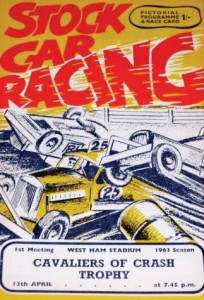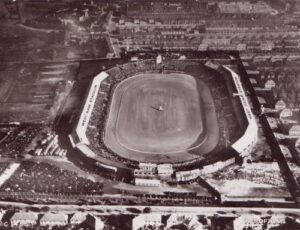 Alan Haines of Folkstone, Kent remembers:
Alan Haines of Folkstone, Kent remembers:
More than 40 years on and I still mourn the demise of London’s West Ham Stadium, a Pantheon to the Gods of Stock Car Racing. In the early to mid-1960s, Dad would take me there on warm summer Saturday evenings. We would pass under the magnificent art deco gateway at the main stand to be confronted by a battery of white-coated vendors. They had trays suspended around their necks and sold paper bags of Percy Dalton’s peanuts still in their shells. Dad would always buy a bag and alternate each peanut with a Nuttall’s Mintoe. It struck me then as an odd combination and still does.
Then the racing started. A cavalcade of multi-coloured liveries. An antidote to a generation weaned on Henry Ford’s philosophy that’any customer can have a car painted any colour he wants so long as it is black.’
The drivers didn’t have ordinary names either, not like my mates in school there were no Roberts or Stevens. A glance in the programme would reveal the names of some real swashbucklers, Chick Henson, Darkie Wright, Jumbo Tustin, Skid Skinner and Tiger Griffin. Move over Indiana Jones.
Imagine up to 35 open wheeled cars crammed onto an oval raceway little larger than a running track. They would be graded according to how successful the driver. A
vehicle with a white roof would indicate a novice, then yellow, blue and through to red, they were the star drivers.To make it competitive and combative the stars would start from the rear of the pack, the white tops at the front and the yellow and blues in-between.

For the stars to be able to take the chequered flag to victory (as they frequently did), they would have to shunt or ram the slower vehicles out of the way. If that’s not mad enough, a number of empty 45 gallon oils drums punctuating the straights and bends just added to the mayhem.
Races always began with a rolling start; one lap at dead slow speed and the cars would trundle round to make sure that all engines were running. Then when Mr Starter frantically waved the green flag, the
grandstand lamps would extinguish leaving only the track lights to illuminate the cars as they hurtled pell-mell in a chaotic melee.
To the aficionados this was a tactically fought battle by the red tops to deposit the slower cars into the safety fence or infield and wend their way to victory. To me it looked just like a free for all as invariably one wag would decide to execute a U-turn and launch himself headlong into the oncoming throng.
Wheels would stray from their axles and roll along the track before hitting an obstacle then launching in the air and bouncing into the terraces causing spectators to cower and shield their heads with their arms. Bonnets would rattle from their hinges then flail for a while before becoming completely dislodged and jettisoning into the path of the pursuing pack.








